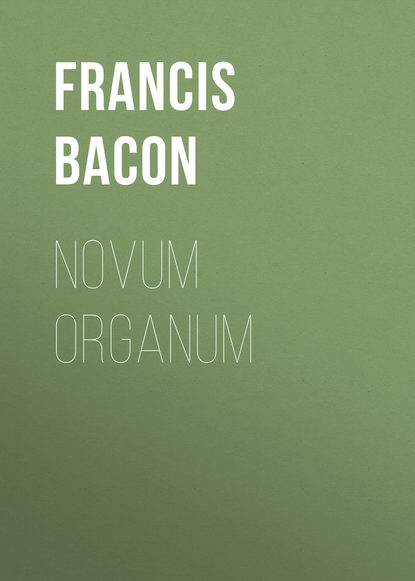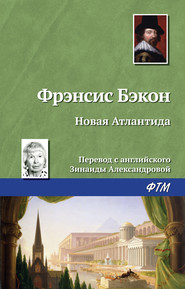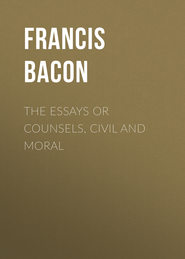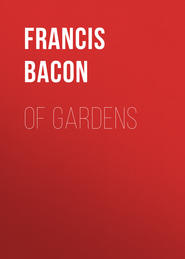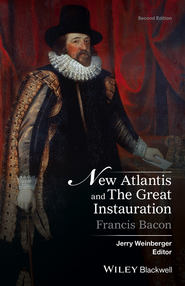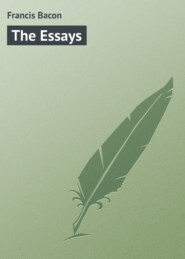По всем вопросам обращайтесь на: info@litportal.ru
(©) 2003-2024.
✖
Novum Organum
Настройки чтения
Размер шрифта
Высота строк
Поля
XIII. In the third place we must exhibit to the understanding the instances in which that nature, which is the object of our inquiries, is present in a greater or less degree, either by comparing its increase and decrease in the same object, or its degree in different objects; for since the form of a thing is its very essence, and the thing only differs from its form as the apparent from the actual object, or the exterior from the interior, or that which is considered with relation to man from that which is considered with relation to the universe; it necessarily follows that no nature can be considered a real form which does not uniformly diminish and increase with the given nature. We are wont to call this our Table of Degrees, or Comparative Instances.
Table of the Degrees or Comparative Instances of Heat
We will first speak of those bodies which exhibit no degree of heat sensible to the touch, but appear rather to possess a potential heat, or disposition and preparation for it. We will then go on to others, which are actually warm to the touch, and observe the strength and degree of it.
1. There is no known solid or tangible body which is by its own nature originally warm; for neither stone, metal, sulphur, fossils, wood, water, nor dead animal carcasses are found warm. The warm springs in baths appear to be heated accidentally, by flame, subterraneous fire (such as is thrown up by Etna and many other mountains), or by the contact of certain bodies, as heat is exhibited in the dissolution of iron and tin. The degree of heat, therefore, in inanimate objects is not sensible to our touch; but they differ in their degrees of cold, for wood and metal are not equally cold.[94 - Bacon here mistakes sensation confined to ourselves for an internal property of distinct substances. Metals are denser than wood, and our bodies consequently coming into contact with more particles of matter when we touch them, lose a greater quantity of heat than in the case of lighter substances. —Ed.] This, however, belongs to the Table of Degrees of Cold.
2. But with regard to potential heat and predisposition to flame, we find many inanimate substances wonderfully adapted to it, as sulphur, naphtha, and saltpetre.
3. Bodies which have previously acquired heat, as horse dung from the animal, or lime, and perhaps ashes and soot from fire, retain some latent portion of it. Hence distillations and separations of substances are effected by burying them in horse dung, and heat is excited in lime by sprinkling it with water (as has been before observed).
4. In the vegetable world we know of no plant, nor part of any plant (as the exudations or pith) that is warm to man’s touch. Yet (as we have before observed) green weeds grow warm when confined, and some vegetables are warm and others cold to our internal touch, i. e., the palate and stomach, or even after a while to our external skin (as is shown in plasters and ointments).
5. We know of nothing in the various parts of animals, when dead or detached from the rest, that is warm to the touch; for horse dung itself does not retain its heat, unless it be confined and buried. All dung, however, appears to possess a potential heat, as in manuring fields; so also dead bodies are endued with this latent and potential heat to such a degree, that in cemeteries where people are interred daily the earth acquires a secret heat, which consumes any recently deposited body much sooner than pure earth; and they tell you that the people of the East are acquainted with a fine soft cloth, made of the down of birds, which can melt butter wrapped gently up in it by its own warmth.
6. Manures, such as every kind of dung, chalk, sea-sand, salt and the like, have some disposition toward heat.
7. All putrefaction exhibits some slight degree of heat, though not enough to be perceptible by the touch; for neither the substances which by putrefaction are converted into animalculæ,[95 - This was the ancient opinion, but the moderns incline to the belief that these insects are produced by generation or fecundity from seeds deposited by their tribes in bodies on the verge of putrefaction. —Ed.] as flesh and cheese, nor rotten wood which shines in the dark, are warm to the touch. The heat, however, of putrid substances displays itself occasionally in a disgusting and strong scent.
8. The first degree of heat, therefore, in substances which are warm to the human touch appears to be that of animals, and this admits of a great variety of degrees, for the lowest (as in insects) is scarcely perceptible, the highest scarcely equals that of the sun’s rays in warm climates and weather, and is not so acute as to be insufferable to the hand. It is said, however, of Constantius, and some others of a very dry constitution and habit of body, that when attacked with violent fevers, they became so warm as to appear almost to burn the hand applied to them.
9. Animals become more warm by motion and exercise, wine and feasting, venery, burning fevers, and grief.
10. In the paroxysm of intermittent fevers the patients are at first seized with cold and shivering, but soon afterward become more heated than at first – in burning and pestilential fevers they are hot from the beginning.
11. Let further inquiry be made into the comparative heat of different animals, as fishes, quadrupeds, serpents, birds, and also of the different species, as the lion, the kite, or man; for, according to the vulgar opinion, fishes are the least warm internally, and birds the most, particularly doves, hawks, and ostriches.
12. Let further inquiry be made as to the comparative heat in different parts and limbs of the same animal; for milk, blood, seed, and eggs are moderately warm, and less hot than the outward flesh of the animal when in motion or agitated. The degree of heat of the brain, stomach, heart, and the rest, has not yet been equally well investigated.
13. All animals are externally cold in winter and cold weather, but are thought to be internally warmer.
14. The heat of the heavenly bodies, even in the warmest climates and seasons, never reaches such a pitch as to light or burn the driest wood or straw, or even tinder without the aid of burning-glasses. It can, however, raise vapor from moist substances.
15. Astronomers tell us that some stars are hotter than others. Mars is considered the warmest after the Sun, then Jupiter, then Venus. The Moon and, above all, Saturn, are considered to be cold. Among the fixed stars Sirius is thought the warmest, then Cor Leonis or Regulus, then the lesser Dog-star.
16. The sun gives out more heat as it approaches toward the perpendicular or zenith, which may be supposed to be the case with the other planets, according to their degree of heat; for instance, that Jupiter gives out more heat when situated beneath Cancer or Leo than when he is beneath Capricorn and Aquarius.
17. It is to be supposed that the sun and other planets give more heat in perigee, from their approximation to the earth, than when in apogee. But if in any country the sun should be both in its perigee and nearer to the perpendicular at the same time, it must necessarily give out more heat than in a country where it is also in perigee, but situated more obliquely; so that the comparative altitude of the planets should be observed, and their approach to or declination from the perpendicular in different countries.
18. The sun and other planets are thought also to give out more heat in proportion as they are nearer to the larger fixed stars, as when the sun is in Leo he is nearer Cor Leonis, Cauda Leonis, Spica Virginis, Sirius, and the lesser Dog-star, than when he is in Cancer, where, however, he approaches nearer to the perpendicular. It is probable, also, that the quarters of the heavens produce a greater heat (though not perceptibly), in proportion as they are adorned with a greater number of stars, particularly those of the first magnitude.
19. On the whole, the heat of the heavenly bodies is augmented in three ways: 1. The approach to the perpendicular; 2. Proximity or their perigee; 3. The conjunction or union of stars.
20. There is a very considerable difference between the degree of heat in animals, and even in the rays of the heavenly bodies (as they reach us), and the heat of the most gentle flame, and even of all ignited substances, nay, liquids, or the air itself when unusually heated by fire. For the flame of spirit of wine, though diffused and uncollected, is yet able to set straw, linen, or paper on fire, which animal heat, or that of the sun, will never accomplish without a burning-glass.
21. There are, however, many degrees of strength and weakness in flame and ignited bodies: but no diligent inquiry has been made in this respect, and we must, therefore, pass it hastily over. Of all flames, that of spirits of wine appears to be the most gentle, except perhaps the ignis fatuus, or the flashes from the perspiration of animals. After this we should be inclined to place the flame of light and porous vegetables, such as straw, reeds, and dried leaves; from which the flame of hair or feathers differs but little. Then, perhaps, comes the flame of wood, particularly that which contains but little rosin or pitch; that of small wood, however (such as is usually tied up in fagots), is milder than that of the trunks or roots of trees. This can be easily tried in iron furnaces, where a fire of fagots or branches of trees is of little service. Next follows the flame of oil, tallow, wax, and the like oily and fat substances, which are not very violent. But a most powerful heat is found in pitch and rosin, and a still greater in sulphur, camphor, naphtha, saltpetre, and salts (after they have discharged their crude matter), and in their compounds; as in gunpowder, Greek fire (vulgarly called wild fire), and its varieties, which possess such a stubborn heat as scarcely to be extinguished by water.
22. We consider that the flame which results from some imperfect metals is very strong and active; but on all these points further inquiry should be made.
23. The flame of vivid lightning appears to exceed all the above, so as sometimes to have melted even wrought iron into drops, which the other flames cannot accomplish.
24. In ignited bodies there are different degrees of heat, concerning which, also, a diligent inquiry has not been made. We consider the faintest heat to be that of tinder, touchwood, and dry rope match, such as is used for discharging cannon. Next follows that of ignited charcoal or cinders, and even bricks, and the like; but the most violent is that of ignited metals, as iron, copper, and the like. Further inquiry, however, must be made into this also.
25. Some ignited bodies are found to be much warmer than some flames; for instance, red hot iron is much warmer, and burns more than the flame of spirits of wine.
26. Some bodies even not ignited, but only heated by the fire, as boiling water, and the air confined in reverberatories, surpass in heat many flames and ignited substances.
27. Motion increases heat,[96 - The correct measure of the activity of flame may be obtained by multiplying its natural force into the square of its velocity. On this account the flame of vivid lightning mentioned in No. 23 (#Tab_3_Inst_23) contains so much vigor, its velocity being greater than that arising from other heat. —Ed.] as is shown in the bellows and the blowpipe; for the harder metals are not dissolved or melted by steady quiet fire, without the aid of the blowpipe.
28. Let an experiment be made with burning-glasses; in which respect I have observed, that if a glass be placed at the distance of ten inches, for instance, from the combustible object, it does not kindle or burn it so readily, as if the glass be placed at the distance of five inches (for instance), and be then gradually and slowly withdrawn to the distance of ten inches. The cone and focus of the rays, however, are the same, but the mere motion increases the effect of the heat.
29. Conflagrations, which take place with a high wind, are thought to make greater way against than with the wind, because when the wind slackens, the flame recoils more rapidly than it advances when the wind is favorable.
30. Flame does not burst out or arise unless it have some hollow space to move and exert itself in, except in the exploding flame of gunpowder, and the like, where the compression and confinement of the flame increase its fury.
31. The anvil becomes so hot by the hammer, that if it were a thin plate it might probably grow red, like ignited iron by repeated strokes. Let the experiment be tried.
32. But in ignited bodies that are porous, so as to leave room for the fire to move itself, if its motion be prevented by strong compression, the fire is immediately extinguished; thus it is with tinder, or the burning snuff of a candle or lamp, or even hot charcoal or cinders; for when they are squeezed by snuffers, or the foot, and the like, the effect of the fire instantly ceases.
33. The approach toward a hot body increases heat in proportion to the approximation; a similar effect to that of light, for the nearer any object is placed toward the light, the more visible it becomes.
34. The[97 - The fires supply fresh heat, the water has only a certain quantity of heat, which being diffused over a fresh supply of cooler water, must be on the whole lowered.] union of different heats increases heat, unless the substances be mixed; for a large and small fire in the same spot tend mutually to increase each other’s heat, but lukewarm water poured into boiling water cools it.
35. The continued neighborhood of a warm body increases heat. For the heat, which perpetually passes and emanates from it, being mixed with that which preceded it, multiplies the whole. A fire, for instance, does not warm a room in half an hour as much as the same fire would in an hour. This does not apply to light, for a lamp or candle placed in a spot gives no more light by remaining there, than it did at first.
36. The irritation of surrounding cold increases heat, as may be seen in fires during a sharp frost. We think that this is owing not merely to the confinement and compression of the heat (which forms a sort of union), but also by the exasperation of it, as when the air or a stick are violently compressed or bent, they recoil, not only to the point they first occupied, but still further back. Let an accurate experiment, therefore, be made with a stick, or something of the kind, put into the flame, in order to see whether it be not sooner burned at the sides than in the middle of it.[98 - If condensation were the cause of the greater heat, Bacon concludes the centre of the flame would be the hotter part, and vice versâ. The fact is, neither of the causes assigned by Bacon is the true one; for the fire burns more quickly only because the draught of air is more rapid, the cold dense air pressing rapidly into the heated room and toward the chimney. —Ed.]
37. There are many degrees in the susceptibility of heat. And, first, it must be observed how much a low gentle heat changes and partially warms even the bodies least susceptible of it. For even the heat of the hand imparts a little warmth to a ball of lead or other metal held a short time in it; so easily is heat transmitted and excited, without any apparent change in the body.
38. Of all bodies that we are acquainted with, air admits and loses heat the most readily, which is admirably seen in weather-glasses, whose construction is as follows: Take a glass with a hollow belly, and a thin and long neck; turn it upside down, and place it with its mouth downward into another glass vessel containing water; the end of the tube touching the bottom of the vessel, and the tube itself leaning a little on the edge, so as to be fixed upright. In order to do this more readily, let a little wax be applied to the edge, not, however, so as to block up the orifice, lest, by preventing the air from escaping, the motion, which we shall presently speak of, and which is very gentle and delicate, should be impeded.
Before the first glass be inserted in the other, its upper part (the belly) should be warmed at the fire. Then upon placing it as we have described, the air (which was dilated by the heat), after a sufficient time has been allowed for it to lose the additional temperature, will restore and contract itself to the same dimensions as that of the external or common atmosphere at the moment of immersion, and the water will be attracted upward in the tube to a proportionate extent. A long narrow slip of paper should be attached to the tube, divided into as many degrees as you please. You will then perceive, as the weather grows warmer or colder, that the air contracts itself into a narrower space in cold weather and dilates in the warm, which will be exhibited by the rising of the water as the air contracts itself, and its depression as the air dilates. The sensibility of the air with regard to heat or cold is so delicate and exquisite, that it far exceeds the human touch, so that a ray of sunshine, the heat of the breath, and much more, that of the hand placed on the top of the tube, immediately causes an evident depression of the water. We think, however, that the spirit of animals possesses a much more delicate susceptibility of heat and cold, only that it is impeded and blunted by the grossness of their bodies.
39. After air, we consider those bodies to be most sensible of heat, which have been recently changed and contracted by cold, as snow and ice; for they begin to be dissolved and melt with the first mild weather. Next, perhaps, follows quicksilver; then greasy substances, as oil, butter, and the like; then wood; then water; lastly, stones and metals, which do not easily grow hot, particularly toward their centre.[99 - Bacon appears to have confounded combustibility and fusibility with susceptibility of heat; for though the metals will certainly neither dissolve as soon as ice or butter, nor be consumed as soon as wood, that only shows that different degrees of heat are required to produce similar effects on different bodies; but metals much more readily acquire and transmit the same degree of heat than any of the above substances. The rapid transmission renders them generally cold to the touch. The convenience of fixing wooden handles to vessels containing hot water illustrates these observations.] When heated, however, they retain their temperature for a very long time; so that a brick or stone, or hot iron, plunged in a basin of cold water, and kept there for a quarter of an hour or thereabout, retains such a heat as not to admit of being touched.
40. The less massive the body is, the more readily it grows warm at the approach of a heated body, which shows that heat with us is somewhat averse to a tangible mass.[100 - Another singular error, the truth being, that solid bodies are the best conductors; but of course where heat is diffused over a large mass, it is less in each part, than if that part alone absorbed the whole quantum of heat. —Ed.]
41. Heat with regard to the human senses and touch is various and relative, so that lukewarm water appears hot if the hand be cold, and cold if the hand be hot.
XIV. Any one may readily see how poor we are in history, since in the above tables, besides occasionally inserting traditions and report instead of approved history and authentic instances (always, however, adding some note if their credit or authority be doubtful), we are often forced to subjoin, “Let the experiment be tried – Let further inquiry be made.”
XV. We are wont to term the office and use of these three tables the presenting a review of instances to the understanding; and when this has been done, induction itself is to be brought into action. For on an individual review of all the instances a nature is to be found, such as always to be present and absent with the given nature, to increase and decrease with it, and, as we have said, to form a more common limit of the nature. If the mind attempt this affirmatively from the first (which it always will when left to itself), there will spring up phantoms, mere theories and ill-defined notions, with axioms requiring daily correction. These will, doubtless, be better or worse, according to the power and strength of the understanding which creates them. But it is only for God (the bestower and creator of forms), and perhaps for angels and intelligences, at once to recognize forms affirmatively at the first glance of contemplation: man, at lest, is unable to do so, and is only allowed to proceed first by negatives, and then to conclude with affirmatives, after every species of exclusion.
XVI. We must, therefore, effect a complete solution and separation of nature; not by fire, but by the mind, that divine fire. The first work of legitimate induction, in the discovery of forms, is rejection, or the exclusive instances of individual natures, which are not found in some one instance where the given nature is present, or are found in any one instance where it is absent, or are found to increase in any one instance where the given nature decreases, or the reverse. After an exclusion correctly effected, an affirmative form will remain as the residuum, solid, true, and well defined, while all volatile opinions go off in smoke. This is readily said; but we must arrive at it by a circuitous route. We shall perhaps, however, omit nothing that can facilitate our progress.
XVII. The first and almost perpetual precaution and warning which we consider necessary is this; that none should suppose from the great part assigned by us to forms, that we mean such forms as the meditations and thoughts of men have hitherto been accustomed to. In the first place, we do not at present mean the concrete forms, which (as we have observed) are in the common course of things compounded of simple natures, as those of a lion, an eagle, a rose, gold, or the like. The moment for discussing these will arrive when we come to treat of the latent process and latent conformation, and the discovery of them as they exist in what are called substances, or concrete natures.
Nor again, would we be thought to mean (even when treating of simple natures) any abstract forms or ideas, either undefined or badly defined in matter. For when we speak of forms, we mean nothing else than those laws and regulations of simple action which arrange and constitute any simple nature, such as heat, light, weight, in every species of matter, and in a susceptible subject. The form of heat or form of light, therefore, means no more than the law of heat or the law of light. Nor do we ever abstract or withdraw ourselves from things, and the operative branch of philosophy. When, therefore, we say (for instance) in our investigation of the form of heat, Reject rarity, or, Rarity is not of the form of heat, it is the same as if we were to say, Man can superinduce heat on a dense body, or the reverse, Man can abstract or ward off heat from a rare body.





